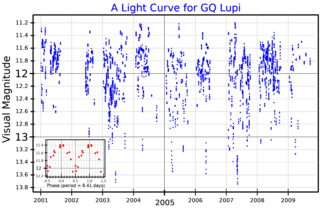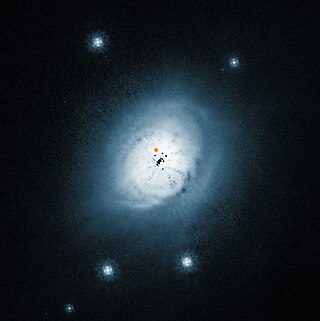
Brown dwarfs are substellar objects that have more mass than the biggest gas giant planets, but less than the least massive main-sequence stars. Their mass is approximately 13 to 80 times that of Jupiter (MJ)—not big enough to sustain nuclear fusion of ordinary hydrogen (1H) into helium in their cores, but massive enough to emit some light and heat from the fusion of deuterium (2H). The most massive ones can fuse lithium (7Li).

A rogueplanet, also termed a free-floating planet (FFP) or an isolated planetary-mass object (iPMO), is an interstellar object of planetary mass which is not gravitationally bound to any star or brown dwarf.

2M1207, 2M1207A or 2MASS J12073346–3932539 is a brown dwarf located in the constellation Centaurus; a companion object, 2M1207b, may be the first extrasolar planetary-mass companion to be directly imaged, and is the first discovered orbiting a brown dwarf.

GQ Lupi is a T Tauri variable star approximately 495 light-years away in the constellation of Lupus. The star is young and has about 70% of the Sun's mass.

GQ Lupi b, or GQ Lupi B, is a possible extrasolar planet, brown dwarf or sub-brown dwarf orbiting the star GQ Lupi. Its discovery was announced in April 2005. Along with 2M1207b, this was one of the first extrasolar planet candidates to be directly imaged. The image was made with the European Southern Observatory's VLT telescope at the Paranal Observatory, Chile on June 25, 2004.

A sub-brown dwarf or planetary-mass brown dwarf is an astronomical object that formed in the same manner as stars and brown dwarfs but that has a planetary mass, therefore by definition below the limiting mass for thermonuclear fusion of deuterium . Some researchers call them rogue planets whereas others call them planetary-mass brown dwarfs. They are sometimes categorized as Y spectral class brown dwarfs.
Gliese 86 is a K-type main-sequence star approximately 35 light-years away in the constellation of Eridanus. It has been confirmed that a white dwarf orbits the primary star. In 1998 the European Southern Observatory announced that an extrasolar planet was orbiting the star.

HD 100546, also known as KR Muscae, is a pre-main sequence star of spectral type B8 to A0 located 353 light-years from Earth in the southern constellation of Musca. The star is surrounded by a circumstellar disk from a distance of 0.2 to 4 AU, and again from 13 AU out to a few hundred AU, with evidence for a protoplanet forming at a distance of around 47 AU.

1RXS J160929.1−210524 is a pre-main-sequence star approximately 450 light-years away in the constellation of Scorpius.

HR 8799 is a roughly 30 million-year-old main-sequence star located 133.3 light-years away from Earth in the constellation of Pegasus. It has roughly 1.5 times the Sun's mass and 4.9 times its luminosity. It is part of a system that also contains a debris disk and at least four massive planets. Those planets, along with Fomalhaut b, were the first exoplanets whose orbital motion was confirmed by direct imaging. The star is a Gamma Doradus variable: its luminosity changes because of non-radial pulsations of its surface. The star is also classified as a Lambda Boötis star, which means its surface layers are depleted in iron peak elements. It is the only known star which is simultaneously a Gamma Doradus variable, a Lambda Boötis type, and a Vega-like star.

HR 8799 b is an extrasolar planet located approximately 129 light-years away in the constellation of Pegasus, orbiting the 6th magnitude Lambda Boötis star HR 8799. It has a mass between 4 and 7 Jupiter masses and a radius from 10 to 30% larger than Jupiter's. It orbits at 68 AU from HR 8799 with an unknown eccentricity and a period of 460 years, and is the outermost known planet in the HR 8799 system. Along with two other planets orbiting HR 8799, the planet was discovered on November 13, 2008 by Marois et al., using the Keck and Gemini observatories in Hawaii. These planets were discovered using the direct imaging technique.

A planetary-mass object (PMO), planemo, or planetary body is, by geophysical definition of celestial objects, any celestial object massive enough to achieve hydrostatic equilibrium, but not enough to sustain core fusion like a star.

HR 8799 e is a large exoplanet, orbiting the star HR 8799, which lies 129 light-years from Earth. This gas giant is between 5 and 10 times the mass of Jupiter. Due to their young age and high temperature all four discovered planets in the HR 8799 system are large, compared to all gas giants in the Solar System.

WISE 1828+2650 is a possibly binary brown dwarf or rogue planet of spectral class >Y2, located in the constellation Lyra at approximately 32.5 light-years from Earth. It is the "archetypal member" of the Y spectral class.

Luhman 16 is a binary brown-dwarf system in the southern constellation Vela at a distance of 6.51 light-years from the Sun. These are the closest-known brown dwarfs and the closest system found since the measurement of the proper motion of Barnard's Star in 1916, and the third-closest-known system to the Sun. The primary is of spectral type L7.5 and the secondary of type T0.5 ± 1. The masses of Luhman 16 A and B are 35.4 and 29.4 Jupiter masses, respectively, and their ages are estimated to be 400–800 million years. Luhman 16 A and B orbit each other at a distance of about 3.5 astronomical units with an orbital period of approximately 26.6 years.

WISE 0855−0714 is a sub-brown dwarf 2.28±0.01 parsecs from Earth, therefore the fourth-closest star or (sub-) brown dwarf system to the Sun, the discovery of which was announced in April 2014 by Kevin Luhman using data from the Wide-field Infrared Survey Explorer (WISE). As of 2014, WISE 0855−0714 has the third-highest proper motion after Barnard's Star and Kapteyn's Star and the fourth-largest parallax of any known star or brown dwarf. It is also the coldest object of its type found in interstellar space, having a temperature in the range 225 to 260 K.

VHS J125601.92–125723.9 is a young triple brown dwarf system located in the constellation Corvus approximately 69.0 light-years from the Sun. The system consists of the equal-mass binary VHS J1256–1257AB and the distant planetary-mass companion VHS 1256–1257 b. In 2022, a continuous radio emission from the radiation belts surrounding VHS J1256–1257 was detected.

A circumplanetary disk is a torus, pancake or ring-shaped accumulation of matter composed of gas, dust, planetesimals, asteroids or collision fragments in orbit around a planet. They are reservoirs of material out of which moons may form. Such a disk can manifest itself in various ways.


















